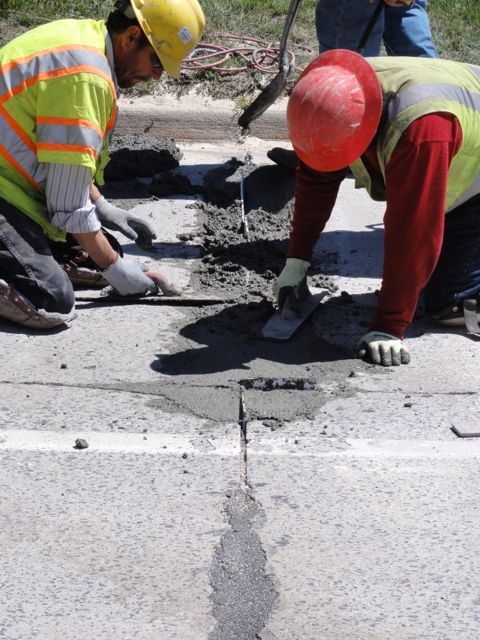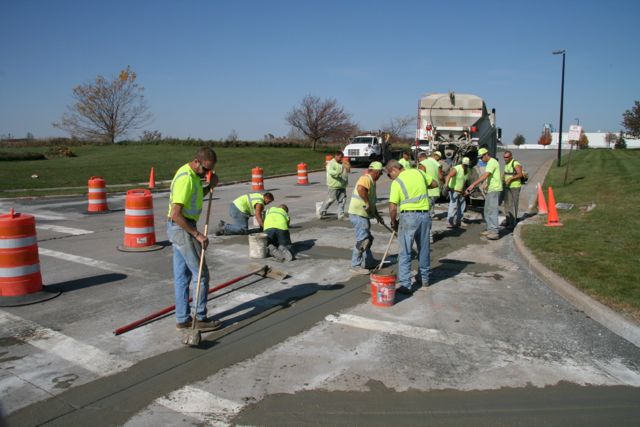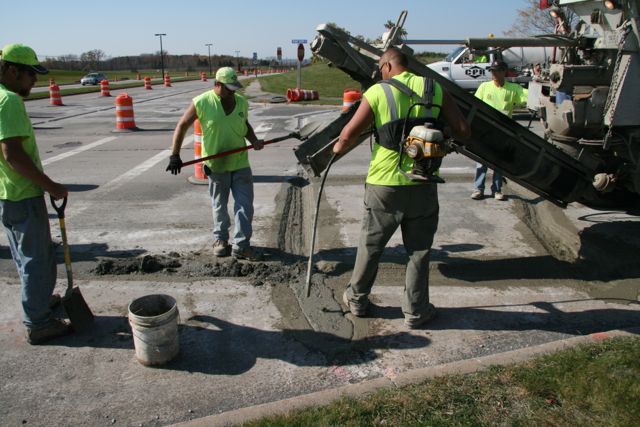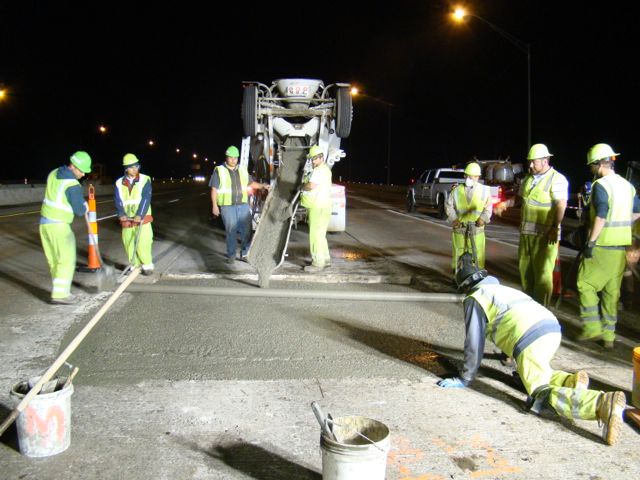What : Partial depth repair restores localized surface distresses which do not extend beyond the upper one third of a rigid (Portland Cement Concrete) pavement. Small, unsound areas of concrete are removed and replaced with suitable repair materials, such as conventional Portland cement concrete mixtures, special cements (such as Gypsum-based cement mixtures and mixes with admixtures to accelerate the cure), and commercially available products such as epoxy and polymer concrete mixtures. The repair material should have good bonding strength. It should also be similar to the existing concrete pavement in strength, modulus of elasticity, and expansion coefficients due to temperature and moisture variations. Bonding agents, such as sand-cement grouts and epoxy agents, are also used on to enhance the bond between the existing concrete and the repair material of partial depth repairs.
: Partial depth repair restores localized surface distresses which do not extend beyond the upper one third of a rigid (Portland Cement Concrete) pavement. Small, unsound areas of concrete are removed and replaced with suitable repair materials, such as conventional Portland cement concrete mixtures, special cements (such as Gypsum-based cement mixtures and mixes with admixtures to accelerate the cure), and commercially available products such as epoxy and polymer concrete mixtures. The repair material should have good bonding strength. It should also be similar to the existing concrete pavement in strength, modulus of elasticity, and expansion coefficients due to temperature and moisture variations. Bonding agents, such as sand-cement grouts and epoxy agents, are also used on to enhance the bond between the existing concrete and the repair material of partial depth repairs.
Full depth repair replaces more severely distressed PCC sections with new material. The first step is identification of the repair limits. The lane-width, full-depth perimeters are then saw-cut, and the slab is removed down to the base. If the base is damaged, it is repaired. Holes are drilled for longitudinal and transverse tie bars; the tie bars are placed to ensure longitudinal and transverse steel continuity; and the excavated area is refilled with new concrete.
Where: Partial depth repair is commonly used to repair low severity spalling but can also be used for small areas with scaling problems. It is also appropriate for low severity scaling of joints, low severity deterioration adjacent to existing repairs, and low severity deterioration of existing repairs.
 For both partial and full depth repairs, experienced personnel perform a thorough field survey complemented with coring, sounding techniques, and FWD load-deflection studies to define the extent of deterioration beneath the surface and determine repair boundaries.
For both partial and full depth repairs, experienced personnel perform a thorough field survey complemented with coring, sounding techniques, and FWD load-deflection studies to define the extent of deterioration beneath the surface and determine repair boundaries.
Full depth repair is indicated where there are low to high severity blow-ups and corner breaks, medium to high severity D-cracking, punch-outs, localized distresses, construction joint distresses, joint deterioration, spalling, reactive aggregate, transverse cracking, deterioration adjacent to existing repairs, and high severity longitudinal cracking.
Why (advantages): Spalling—cracking, breaking, chipping, or fraying of concrete slab edges at joints and cracks—reduces pavement serviceability, and if left unrepaired, it can become hazardous to highway users. Partial depth repair preserves the pavement, extending its life and safety.
F ull Depth Repair is an effective, permanent treatment to repair pavement distresses, particularly those that occur at or near joints and cracks. By removing and replacing isolated areas of deterioration, full-depth repairs may delay or stop further deterioration and restore the pavement to its original condition. With proper design and construction practices, full-depth repairs should perform for as long as the surrounding concrete slabs.
ull Depth Repair is an effective, permanent treatment to repair pavement distresses, particularly those that occur at or near joints and cracks. By removing and replacing isolated areas of deterioration, full-depth repairs may delay or stop further deterioration and restore the pavement to its original condition. With proper design and construction practices, full-depth repairs should perform for as long as the surrounding concrete slabs.
Why not (disadvantages): Partial Depth Repairs: Partial depth repair is not appropriate for spalls caused by material problems, such as D-cracking, Alkali-Silica Reactivity (ASR), or by lockup or corrosion of dowel bars at transverse joints. Such spalls usually indicate deterioration beyond the upper one-third of the pavement; therefore in these instances a full depth repair would be more appropriate. Partial depth repair is also not appropriate for moderately severe spalls extending more than 6-10” from joints or with exposed reinforcing steel or load transfer devices, because they typically indicate more severe damage requiring full depth slab repair.
F ull Depth Repairs: If the existing pavement is not structurally sound, it is nearing end of its fatigue life, it has a severe material problem, or the deterioration extends over the entire project length, it is too late for pavement preservation. In these cases a structural enhancement (such as an overlay) or rehabilitation may be more cost-effective to prevent continued cracking. Joints added by full-depth repairs add to the pavement roughness, even if the pavement is diamond ground after the repairs are made.
ull Depth Repairs: If the existing pavement is not structurally sound, it is nearing end of its fatigue life, it has a severe material problem, or the deterioration extends over the entire project length, it is too late for pavement preservation. In these cases a structural enhancement (such as an overlay) or rehabilitation may be more cost-effective to prevent continued cracking. Joints added by full-depth repairs add to the pavement roughness, even if the pavement is diamond ground after the repairs are made.
When: When routine pavement distress surveys indicate further investigation is needed, subsequent coring, sounding techniques, and FWD load-deflection studies should be used to determine when both types of repairs should be made.
Estimated life extension: 3-14 years.
For more information, see the Checklists for Partial and Full Depth Concrete Repair put together by FHWA and the Foundation for Pavement Preservation.
